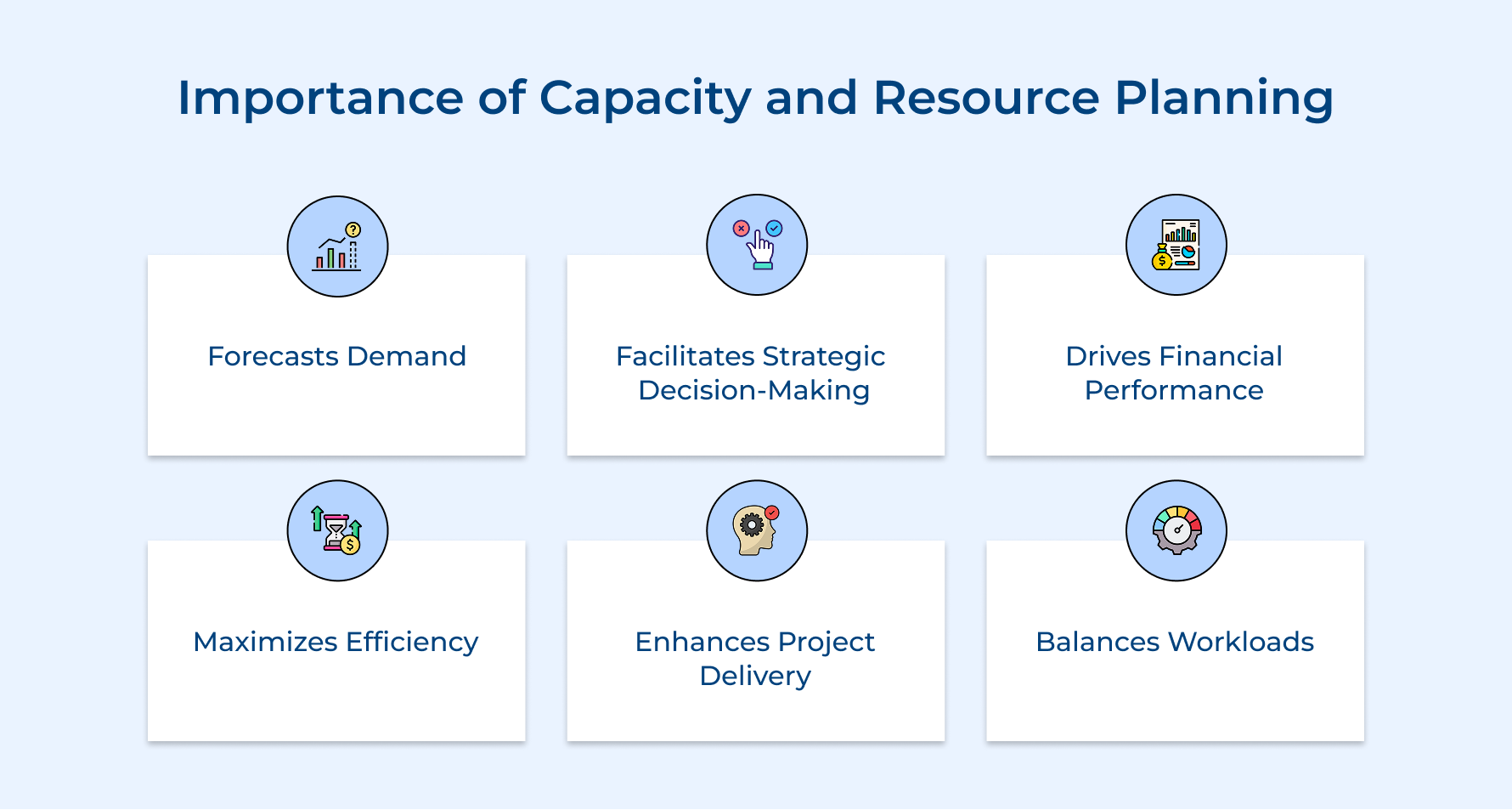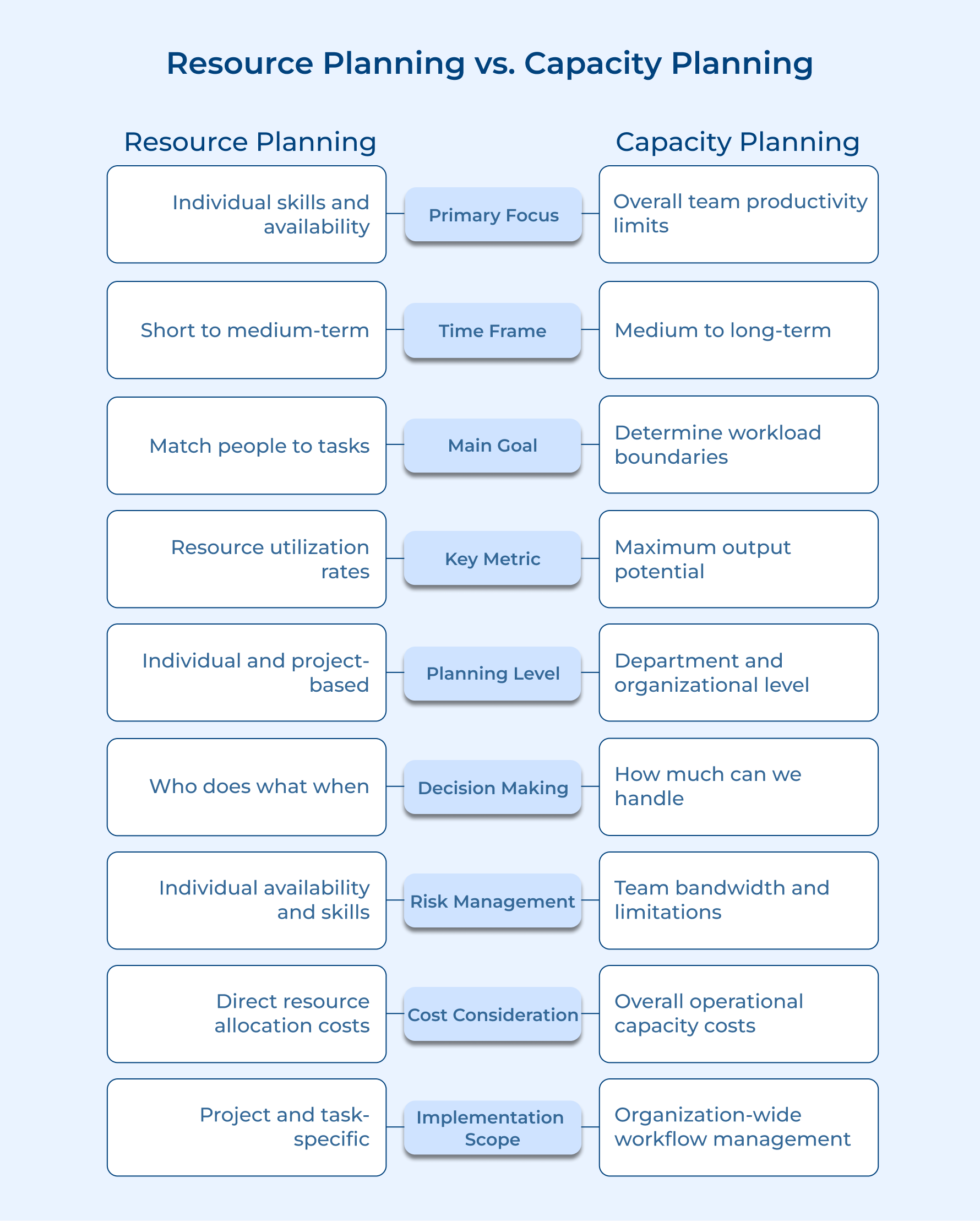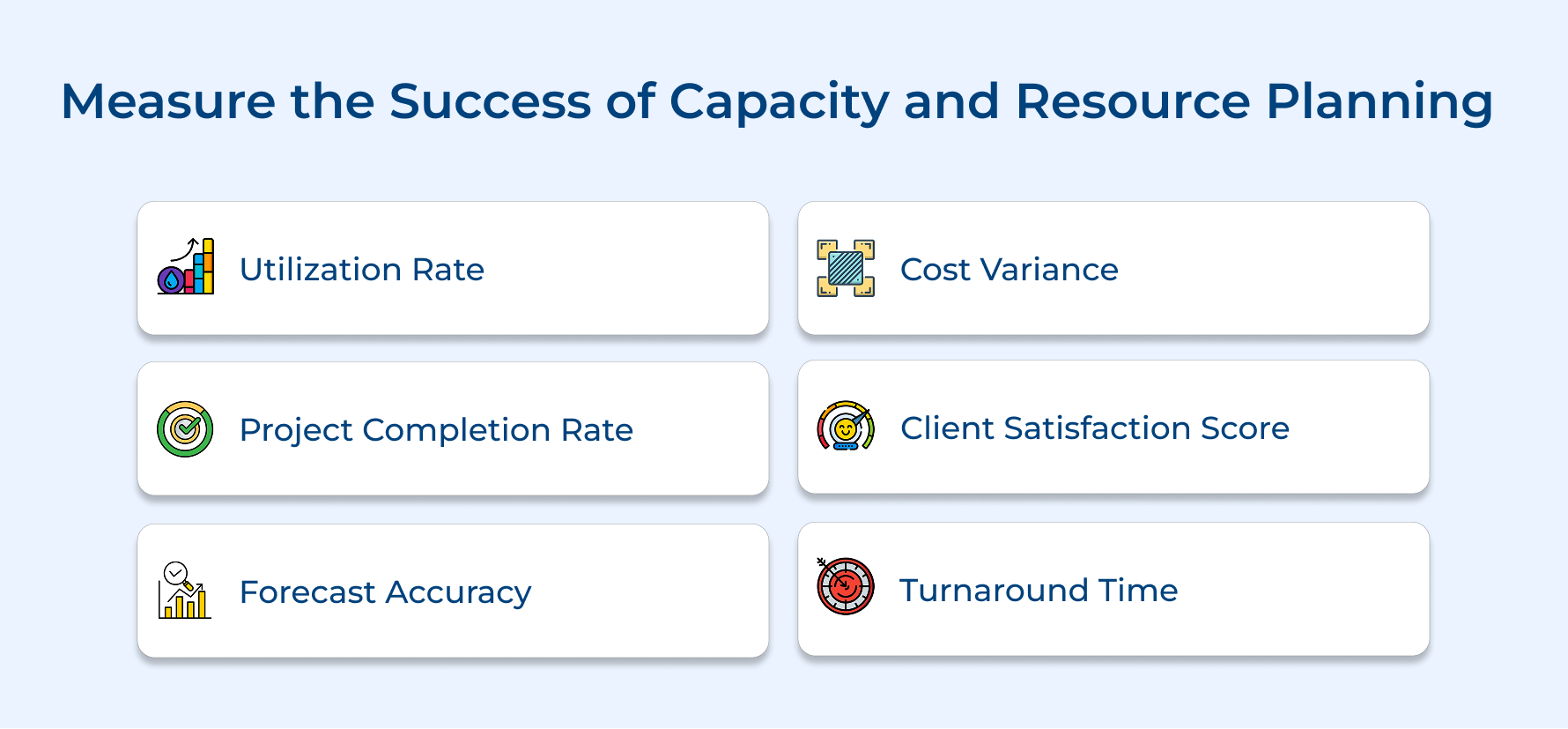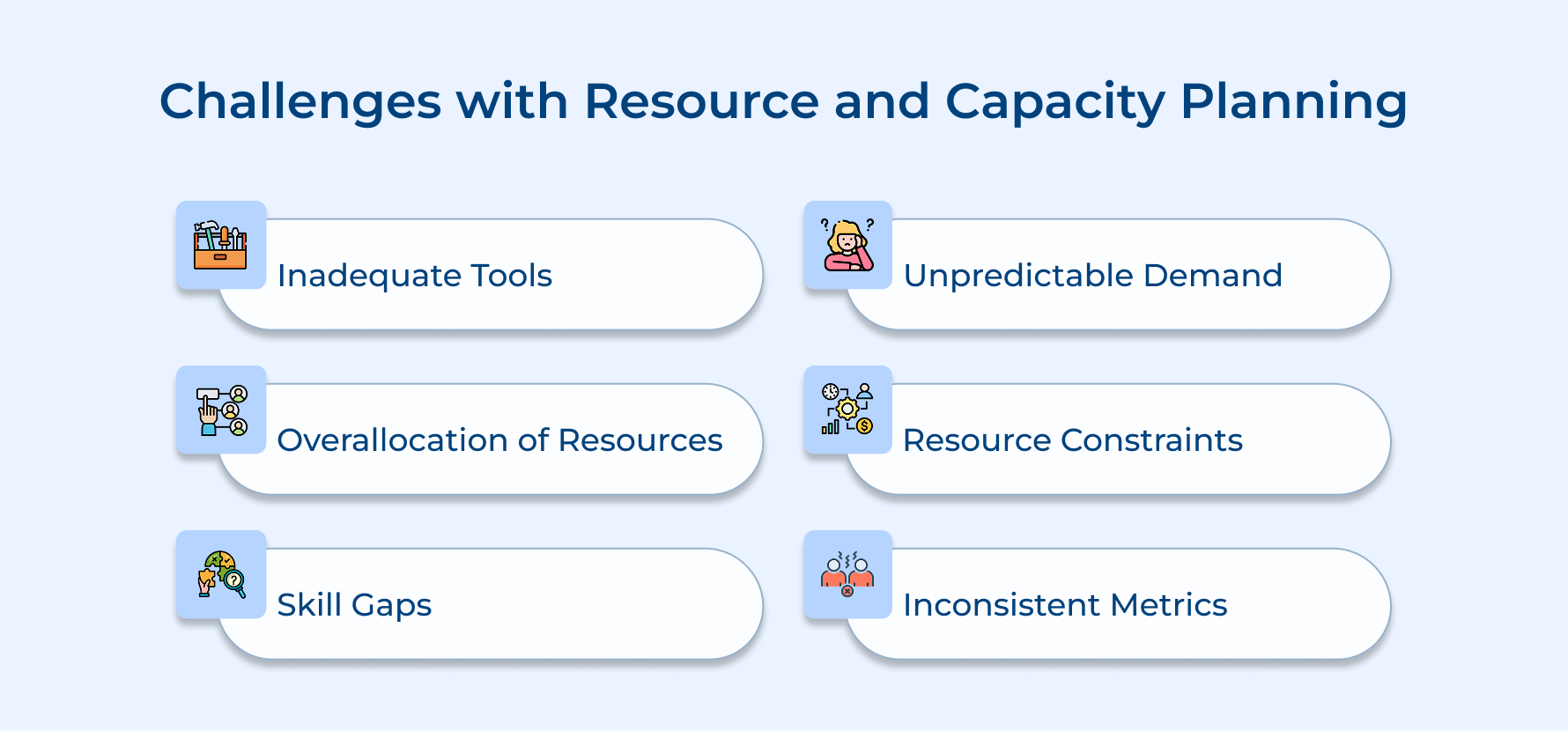Capacity Planning vs Resource Planning: Differences & Metrics
- What is Capacity Planning?
- What is Resource Planning?
- Importance of Capacity and Resource Planning
- What is the Difference Between Resource Planning and Capacity Planning?
- Metrics to Measure the Success of Capacity and Resource Planning
- Best Practices for Effective Capacity and Resource Planning
- Common Challenges with Resource and Capacity Planning
- Future-Proofing Your Agency: Balancing Capacity and Resource Needs
- FAQs about Capacity Planning vs Resource Planning

Key Highlights:
- Resource planning focuses on immediate needs; capacity planning aligns with long-term organizational goals.
- Utilization rate measures resource efficiency by comparing billable hours to total available hours.
- Automate capacity planning tasks to improve accuracy, reduce errors, and save time for strategy.
Navigating project management can get tricky, especially when it comes to understanding the difference between capacity planning and resource planning. These two concepts often get mixed up, leading to confusion, inefficiencies, and missed opportunities.
But here’s the thing: knowing how they differ is the key to streamlining operations and hitting your business goals.
So, what’s the deal with these two?
Capacity planning is all about looking ahead while resource planning is more focused on the here and now.
Let’s understand the differences, break down both approaches and show you why they’re essential for driving success.
What is Capacity Planning?
Capacity planning is the process of determining the production capacity needed by an organization to meet changing demands for its products or services. A strategic approach ensures that an organization can meet its operational goals without overextending itself through informed decision-making.
Overcapacity can lead to wasted resources and increased costs, while under capacity can result in missed opportunities or dissatisfied customers. Effective capacity planning helps organizations align their production capabilities with market demands. Hence, ensuring that they can respond swiftly to changes in customer preferences or economic conditions.
Key objectives:
- Meeting demand fluctuations: Ensuring that production capabilities align with anticipated demand changes helps prevent shortages and excesses in inventory.
- Optimizing resource allocation: Efficiently managing resources—such as labor, equipment, and materials—reduces operational costs while enhancing productivity.
- Enhancing flexibility: Developing strategies for scaling operations up or down allows organizations to respond swiftly to market changes without sacrificing quality.
What is Resource Planning?
Resource planning is the systematic process of identifying, allocating, and managing the resources required for a project/operation. It encompasses various resources such as human capital, financial assets, materials, equipment, and time.
Effective resource planning ensures that all necessary elements are in place for successful project execution, facilitating optimal performance and minimizing waste. Proper resource planning also contributes to better risk management, helping identify potential bottlenecks or constraints before they impact project timelines or outcomes.
Key objectives:
- Optimal resource allocation: Ensures that resources are assigned efficiently to various tasks, maximizing productivity and minimizing downtime.
- Cost management: Helps in budgeting by providing a clear view of resource needs and associated costs, allowing for better financial control.
- Risk mitigation: Identifies potential resource-related risks early in the project lifecycle, enabling proactive strategies to address them.
- Enhanced collaboration: Promotes communication among team members and stakeholders, ensuring everyone is informed about resource availability as well as project timelines.
Importance of Capacity and Resource Planning
Understanding the significance of capacity and resource planning is essential for optimizing operations. Here are the key points.
- Forecasting Demand
Analyzing historical data, market trends, and client needs helps you anticipate future demands. It means you can avoid the chaos of overcommitting or the waste of underutilized resources, staying ahead of fluctuations and responding proactively.
- Facilitating Strategic Decision-making
When you’ve got solid capacity planning in place, you’re armed with the data you need to make smart decisions. Whether it’s hiring new talent, investing in tools, or tweaking operations, you can align your choices with your long-term goals and steer your agency in the right direction.
- Driving Financial Performance
Good capacity management is a win for your bottom line. It reduces waste, improves resource use, and keeps operational costs in check. The result? Higher profitability and more resources to reinvest in growth, innovation, or wherever you want to take your agency next.
- Maximizing Efficiency
Resource management ensures every person and tool in your agency is being put to good use. By streamlining processes and cutting out inefficiencies, your team can achieve more with the same resources.
- Enhancing Project Delivery
Getting resources right is key to delivering projects on time. With the right people and tools in place, projects run smoothly, deadlines are met, as well as clients stay happy. Plus, consistent delivery is what helps you stay ahead of the competition.
- Balancing Workloads
Nobody wants to deal with burnout, and that’s where resource management shines. It helps distribute work evenly across your team, creating a sustainable and positive work environment. Happy, balanced teams are more motivated and more likely to stick around, making your agency stronger in the long run.
What is the Difference Between Resource Planning and Capacity Planning?
Clarifying the differences between resource planning and capacity planning is vital for effective project management. Here are the distinctions.
1. Focus and Scope
Resource planning zooms in on the nitty-gritty details of specific projects. It’s all about figuring out what resources (people, tools, or materials) are needed, how much is required, and when they need to be available. It’s project-focused and ensures everything is lined up to hit the project goals.
On the flip side, capacity planning takes a big-picture view. It’s about assessing the organization’s overall ability to meet future demand. By identifying gaps between current capabilities and what’s needed down the line, capacity planning helps align resources with long-term business goals as well as market trends.
2. Timeframe
Resource planning operates in the short term, usually tied to the duration of specific projects or tasks. It’s tactical and adjusts as projects evolve, ensuring immediate needs are met without derailing progress.
Capacity planning, however, plays the long game. It forecasts future demands over months or even years, allowing organizations to adapt their resource strategies in advance. The strategic approach ensures a balance between supply and demand over the long haul.
3. Objectives
The goal of resource planning is straightforward: get the right resources to the right place at the right time. It’s about optimizing resource use, cutting down idle time, and keeping project costs under control. For project managers, this is essential to hitting deadlines and maintaining quality.
Meanwhile, the capacity planning strategy is all about ensuring the organization can handle future workloads without overstretching. It’s about identifying gaps, predicting demands, and preparing for what’s next. The approach drives smarter decisions about hiring, training, and investments, setting the stage for sustainable growth.
4. Tools and Techniques
Resource planning leans on tools like Gantt charts, resource allocation matrices, and project management software. These help track resource availability, manage workloads, and spot constraints early. Techniques like critical path analysis also come in handy for keeping projects on schedule.
Capacity planning uses tools like demand forecasting, utilization rates, and scenario analysis. Specialized software often integrates with existing systems to analyze data, predict demand, and model different scenarios. Advanced techniques like linear programming can also optimize resource allocation based on capacity constraints.
5. Types of Planning
Resource planning can be broken down into:
- Human resource planning (staffing needs)
- Equipment planning (tools and machinery)
- Material planning (supplies and inventory)
Capacity planning has its own types:
- Long-term capacity planning (big resource or infrastructure investments)
- Medium-term capacity planning (adapting to seasonal fluctuations)
- Short-term capacity planning (responding to immediate changes or emergencies)
Each type plays a crucial role in keeping operations smooth, regardless if you’re focused on the current projects or preparing for what’s next.
Metrics to Measure the Success of Capacity and Resource Planning
Tracking metrics helps you assess the effectiveness of capacity and resource planning. Here are important metrics to consider.
Utilization Rate
The utilization rate measures the percentage of billable hours worked by employees compared to their total available hours. High utilization rates indicate efficient use of team members for client projects, ensuring that resources are maximized without leading to employee burnout.
Project Completion Rate
Tracking the percentage of projects completed on time and within budget provides insight into project performance. High completion rates reflect effective capacity planning and resource allocation, helping identify patterns that can inform future planning efforts.
Forecast Accuracy
Forecast accuracy assesses how well the projected workload aligns with actual demand. Accurate forecasts enable agencies to allocate resources effectively and meet client expectations. Regularly reviewing and refining forecasting methods enhances accuracy as well as responsiveness to market changes.
Cost Variance
Analyzing the difference between budgeted and actual project costs provides insights into financial performance. Monitoring cost variance helps agencies control spending, ensuring resources are allocated effectively while keeping projects profitable.
Client Satisfaction Score
Gauging client satisfaction with services through surveys or feedback indicates the effectiveness of resource planning. High satisfaction scores typically result from well-managed resources and timely deliverables, reflecting positively on the agency’s performance.
Turnaround Time
Measuring how quickly requests or projects are completed reveals operational efficiency. Short turnaround times suggest effective resource management, while long turnaround times may indicate process bottlenecks. Tracking this metric supports improvements in responsiveness to client needs.
Best Practices for Effective Capacity and Resource Planning
Implementing best practices enhances the efficiency of capacity and resource planning. Here are the top strategies to follow.
Align with Business Goals
Ensure capacity planning aligns with overall business objectives. The alignment helps prioritize projects and allocate resources effectively, supporting strategic growth while enhancing organizational performance.
Monitor Resource Utilization
Track resource utilization metrics continuously. Monitoring helps identify underused or overused resources, allowing for adjustments that optimize performance and ensure resources are available when needed.
Leverage Automation
Automate repetitive capacity planning tasks where possible. Automation reduces manual errors and frees up time for strategic planning, allowing teams to focus on more critical aspects of capacity management.
Define Clear Roles
Clearly define roles and responsibilities for team members. The clarity helps streamline resource allocation and ensures everyone knows their tasks, promoting accountability as well as enhancing collaboration.
Utilize Resource Management Tools
Implement resource management software to track availability and allocation. These tools facilitate real-time insights, allowing for effective scheduling and preventing overallocation or underutilization of resources.
Review and Adjust Regularly
Conduct regular reviews of resource planning strategies and outcomes. Ongoing evaluations help identify areas for improvement and ensure that resource management remains aligned with organizational goals.
Common Challenges with Resource and Capacity Planning
Resource managers should recognize challenges in resource and capacity planning as it is essential for overall improvement. Here are the common obstacles faced.
Inadequate Tools
Many organizations rely on outdated tools for resource management, leading to inefficiencies and increased manual effort.
How to prevent: Adopting modern resource management software can streamline processes, providing real-time insights and improving allocation accuracy. Regular training sessions on these tools also enhance user proficiency, ensuring effective utilization and maximizing the return on investment.
Overallocation of Resources
Overworking team members can lead to burnout, reduced morale, and decreased productivity.
How to fix: Implementing clear workload monitoring systems can help identify when resources are stretched too thin, facilitating timely interventions. Encouraging open communication among team members allows them to voice concerns, enabling managers to make timely adjustments to workload distribution and improve overall team health.
Skill Gaps
Limited skills within the team can significantly hinder project success and overall performance.
Fix it through: Conducting regular skills assessments helps identify existing gaps, allowing for targeted training programs tailored to the team’s needs.
Collaborating with external experts or offering mentorship opportunities can further enhance team capabilities, ensuring the right skills are available for each project and driving better outcomes.
Unpredictable Demand
Fluctuating market conditions can make it challenging to accurately forecast demand, resulting in either underutilization or overextension of resources.
How to solve: Utilizing advanced analytics tools can help analyze historical data and trends, enabling more accurate predictions of future needs. Scenario planning allows organizations to prepare for various demand levels.
Resource Constraints
Limited resources can hinder effective capacity planning and impact project timelines.
Fix it through: Conducting a thorough inventory of available resources and identifying potential bottlenecks helps in better allocation as well as strategic planning. Developing a flexible resource pool can also allow for quick adjustments based on project needs, ensuring that the organization remains agile in dynamic environments.
Inconsistent Metrics
Varying metrics across different departments can complicate capacity planning efforts and hinder data-driven decisions.
How to prevent: Establishing standardized metrics across the organization ensures consistency in measurement and reporting. Regularly reviewing these metrics can help identify areas for improvement and enhance the overall accuracy of capacity assessments, leading to better resource allocation strategies.
Future-Proofing Your Agency: Balancing Capacity and Resource Needs
Effective capacity planning and resource planning are essential for agencies as well as professional services seeking to optimize operations while enhancing client satisfaction. Understanding the differences between these two processes enables organizations to allocate resources efficiently while preparing for future demands.
Implementing best practices and regularly monitoring key metrics can significantly improve overall performance as well as responsiveness. Balancing both planning approaches ensures projects are completed on time and within budget, ultimately contributing to business growth.
A strategic focus on capacity and resource planning equips organizations to navigate challenges as well as seize opportunities in an ever-evolving marketplace. The proactive approach enhances resilience and adaptability, vital for long-term success.
Limit time — not creativity
Everything you need for customer support, marketing & sales.
Neeti Singh is a passionate content writer at Kooper, where he transforms complex concepts into clear, engaging and actionable content. With a keen eye for detail and a love for technology, Tushar Joshi crafts blog posts, guides and articles that help readers navigate the fast-evolving world of software solutions.



